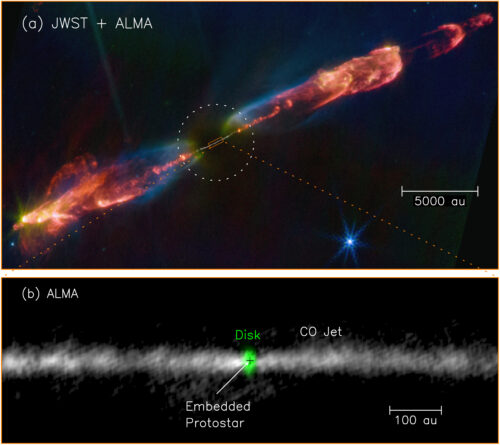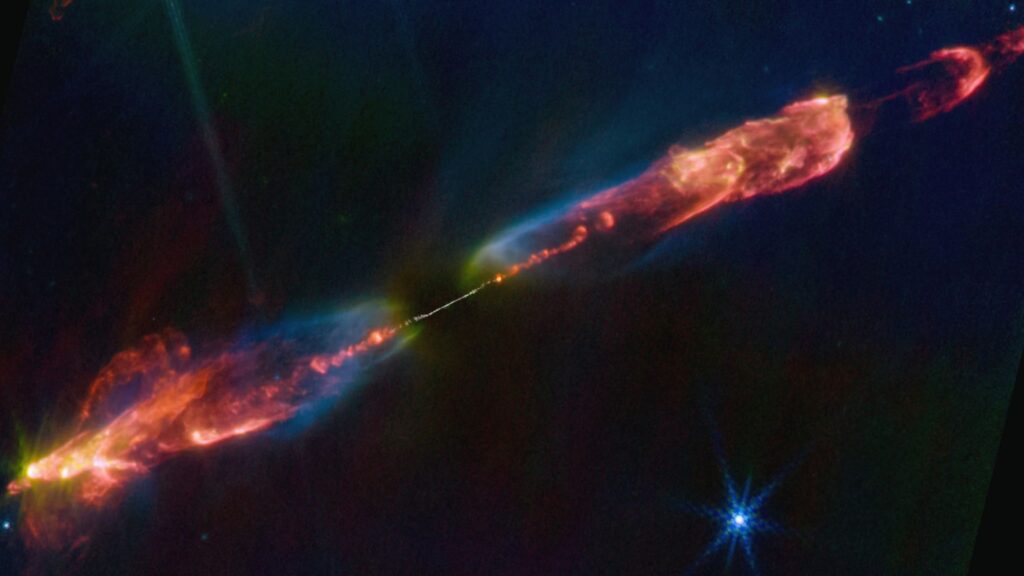simple facts
What it is: HH 211, a baby star that erupts with a huge jet of energy
Location: 1,000 light years from Earth in the constellation Perseus.
Share date: September 17, 2025
Most events in the universe are not completely understood, including the relatively simple process of star formation. Stars form in dense clouds of cold gas and dust. When these clouds reach a threshold mass, they collapse under their own gravity, leading to the birth of baby stars or protostars.
If the accretion disk spins too fast, material will have a hard time falling toward the star. Astronomers believe that the baby star may blow away some material in the accretion disk in the form of high-energy jets (known as protostellar jets), thereby facilitating the process of transferring some material to the star.
But the main challenge in confirming this is that these jets come from regions very close to the star, meaning that even some of the most powerful telescopes cannot observe or image them. Therefore, astronomers do not know how these jets are ejected or where they originate.
Researchers have previously proposed that the magnetic fields of protostar systems may help launch these jets. And new images shed light on the problem for the first time.

In a study published August 13 in the journal Scientific Reports, researchers used Chile’s Atacama Large Millimeter/Submillimeter Array (ALMA) to study an object called HH 211 located 1,000 light-years away in the constellation Perseus. HH 211 is a Herbig halo object, a bright region of a nebula formed by a powerful jet of a newborn star. This protostar system is only 35,000 years old, and the small protostar at its center weighs just 0.06 times the mass of the Sun.
HH 211 is characterized by a bright dipolar jet, two beams of energized ionized material emerging in opposite directions. This system is one of the few known examples where a magnetic field has been detected and provides a valuable opportunity to investigate magnetic field-induced emission models.
ALMA observations of the system showed the jet rocketing at a speed of about 66 miles per second (107 kilometers per second), but interestingly, it was found to be rotating very slowly with a certain angular momentum. This suggests that the bipolar jet carried away excess rotational energy. By taking into account conservation of angular momentum and energy, the researchers calculated that the jet came from the innermost edge of the accretion disk, just 0.02 AU, or nearly 1.85 million miles (3 million kilometers) from the star.
Their results are consistent with one model that explains how magnetic fields act like a slingshot, shooting gas outward.
In this spectacular image, a colorful display of a bipolar jet is captured in near-infrared wavelengths by the James Webb Space Telescope (JWST). However, JWST’s view is obscured by thick dust surrounding the central area.
This hidden area is very important because it is where the jets originate. Thanks to new research, ALMA data has revealed a significant thin section centered at submillimeter wavelengths. Here we overlay ALMA data with JWST data to create a complete picture of how new stars form. A magnified grayscale image taken by ALMA clearly shows jets launching from the accretion disk.
This is the first time that the launch location of a protostar jet has been captured. The discovery also confirmed that these jets play an important role in the growth of newborn stars by removing angular momentum from the accretion disk, allowing material to fall more easily into the star.
For more sublime space images, check out this week’s space photo archive.
Source link

